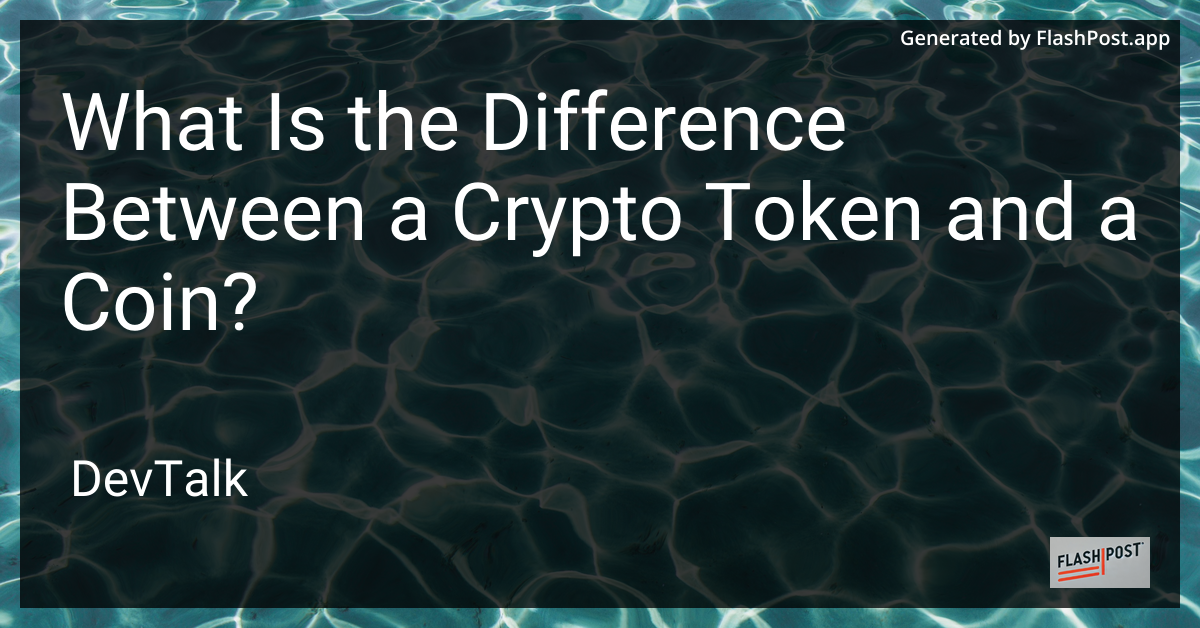What Is the Difference Between a Crypto Token and a Coin?

What is the Difference Between a Crypto Token and a Coin?
In the ever-evolving world of cryptocurrency, understanding the distinction between different digital assets is crucial for investors, traders, and enthusiasts alike.
Two of the most commonly used terms you'll encounter are "crypto tokens" and "coins." While they may seem interchangeable to newcomers, they represent different facets of the crypto ecosystem. This article will delve into the key differences between crypto tokens and coins, helping you make informed decisions in your cryptocurrency journey.
What is a Crypto Coin?
Crypto coins are digital currencies that operate independently on their own blockchain. They are primarily used as a medium of exchange, store of value, or as a unit of account. The most famous example of a crypto coin is Bitcoin. It was the first cryptocurrency and remains the most valuable in terms of market capitalization. Other popular coins include Ethereum (ETH), Litecoin (LTC), and Ripple (XRP).
Characteristics of Crypto Coins:
- Independent Blockchain: Coins operate on their own blockchain.
- Directly Used as Currency: Intended for transactions and as a store of value.
- Examples: Bitcoin, Ethereum, and Litecoin.
What is a Crypto Token?
Crypto tokens, on the other hand, are digital assets that are created on already existing blockchains. They are often used to represent an asset or utility and can serve various purposes within their respective ecosystems. Tokens are created through smart contracts and can be customized for unique functions beyond simple transactions.
Characteristics of Crypto Tokens:
- Operate on Existing Blockchains: Tokens are built on top of existing blockchains like Ethereum, using standards like ERC-20 and ERC-721.
- Variety of Uses: Tokens can represent assets, grant access to specific services, or even act as security for investments.
- Examples: Tether (USDT), Chainlink (LINK), and Uniswap (UNI).
Key Differences Between Coins and Tokens
-
Blockchain Dependency:
- Coins are native to their own blockchains.
- Tokens exist on other blockchains.
-
Primary Use:
- Coins are straightforward currencies.
- Tokens often have wider functionalities, from service access to asset representation.
-
Creation:
- Coins are mined or staked through network consensus mechanisms.
- Tokens are created through smart contract execution on platforms like Ethereum.
Why Knowing the Difference Matters
Understanding the differences between coins and tokens is crucial for anyone involved in cryptocurrency trading strategies or considering investments. Each type of digital asset comes with its own set of potential benefits and risks, which you should evaluate before diving in. For more insights into the risks associated with cryptocurrency investments, check out this guide on cryptocurrency investment risks.
Additionally, knowing how to properly receive and manage cryptocurrencies, whether coins or tokens, is a vital skill. Learn more on how to efficiently handle digital currencies by visiting this tutorial on cryptocurrency receiving through platforms like Coinbase.
Conclusion
In summary, while both crypto tokens and coins play significant roles within the cryptocurrency ecosystem, their purposes and functionalities differ considerably. Recognizing these differences will empower you to make strategic decisions in trading and investment, thereby enhancing your overall crypto experience. As the digital currency landscape continues to evolve, staying informed and understanding the intrinsic attributes of tokens and coins will be key to seizing future opportunities.